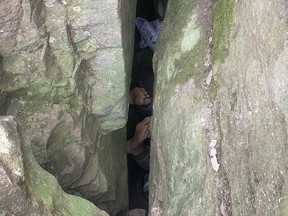The ancient site had been looted through the centuries, but in 1959 archeologists noticed where the roof of the tomb had collapsed, leading them to the 3,500-year-old armour
Article content
More than 60 years ago, one of the oldest complete suits of European armour was discovered near the village of Dendra, in Southern Greece. The site had been picked over and looted through the centuries, but in 1959 a team of Greek and Swedish archeologists noticed where the roof of an ancient tomb had collapsed, marking it for further exploration.
A year later, the tomb had already been partially plundered, but researchers were able to recover a trove of items that included pottery, a silver pin, a bronze jug, a gold-plated ring, fragments of a silver cup — and a bronze suit of armour, slightly squashed but since restored and now known as the Dendra panoply.
Advertisement 2
Article content
Since the armour was found in a tomb, archeologists were uncertain whether it had been created for purely ceremonial use or to wade into actual battle. So they decided to put it to the test.
A recent paper published in the journal PLOS ONE describes how a group of Marines from the Hellenic Armed Forces — the military forces of modern-day Greece — donned replica versions of the armour for a day-long “simulated Late Bronze Age combat protocol.” Imagine a weird combination of a modern war game, a historical re-enactment and a live-action roleplay.
The researchers didn’t have much information regarding what a battle waged three and a half millennia ago would have looked like, so they turned to The Iliad. Homer’s epic poem is set during the Trojan War, which took place in the 12th or 13th century BCE, making the timing more or less right, although the researchers note that the work was penned some 500 years after the events it describes. Still, it’s the best account we’ve got and, as luck would have it, other historians had already combed through it and documented the fighting techniques of the time.
Article content
Advertisement 3
Article content
“Homer describes the majority of warriors as strong, fast, and skilled mature men,” the researchers write in their paper, titled Analysis of Greek prehistoric combat in full body armour based on physiological principles. “Also, many of the elite warriors are described as tall and physically impressive.”
But they knew some of this might be poetic licence, so they also researched archeological evidence. They found that the average Greek male of the Late Bronze Age was about five-foot-five, but that the elite males from a site known as Grave Circle B were closer to five-ten. So they chose 13 volunteers from among the Marines who were five-foot-nine, averaging 29 years old and 160 pounds.
Recommended from Editorial
The original armour remains on display at the Nafplio Museum in southern Greece. Earlier experiments with replicas demonstrated its flexibility for use in combat but not its suitability for use in extended battle situations. So researchers sought out replicas that had been made in Birmingham, U.K., in 1984.
Advertisement 4
Article content
The replica armour was made of 95 per cent copper and five per cent zinc, which they concluded was “the closest alloy to the original bronze available.” The suit, including a leather inner cap, weighed 23.32 kilos (51.4 pounds) and offered “considerable protection against most blows,” they wrote.
The modern Greek warriors also carried replica weapons, with blunt edges to prevent the Trojan War claiming any more casualties. In an effort to match the fighting conditions as closely as possible, researchers also studied the terrain where the Trojan War was fought, and the climate conditions of the time. They even fed their warriors a Bronze-Age diet, with breakfast of dry bread, goat’s cheese, olives and red wine; snacks of dry bread, honey, goat’s cheese and onions through the 11-hour day; and meat (sheep/goat/pig/cow) and red wine as the main components of dinner, along with more bread and cheese.
The results? “We now understand, despite (the armour’s) cumbersome appearance at first sight, that it is not only flexible enough to permit almost every movement of a warrior on foot but also resilient enough to protect the wearer from most blows. In addition, our experiments have now demonstrated, we hope convincingly, that the armour is also of a weight and structure to permit extended use in combat, day after day, for up to 11 hours, without detriment to a fit warrior (although, apart from the Iliad, we have no accounts of battles of such duration).”
Advertisement 5
Article content
The paper concludes that the results enrich “both our understanding of ancient Greek and Late Bronze Age warfare and the potential contexts in which it took place. It supplies a robust scaffold to support fresh research regarding the events that have underpinned social transformations in both prehistoric Europe and the Eastern Mediterranean.” It adds: “This may also help shed much-needed light on one of history’s most frightful turning points: the collapse of the Eastern Mediterranean Bronze Age civilizations towards the end of the 2nd Millennium BC, a time of destruction and upheaval that marked the beginning of the Age of Iron.”
All from an ancient suit of armour and some willing modern Marines.
Our website is the place for the latest breaking news, exclusive scoops, longreads and provocative commentary. Please bookmark nationalpost.com and sign up for our daily newsletter, Posted, here.
Article content









